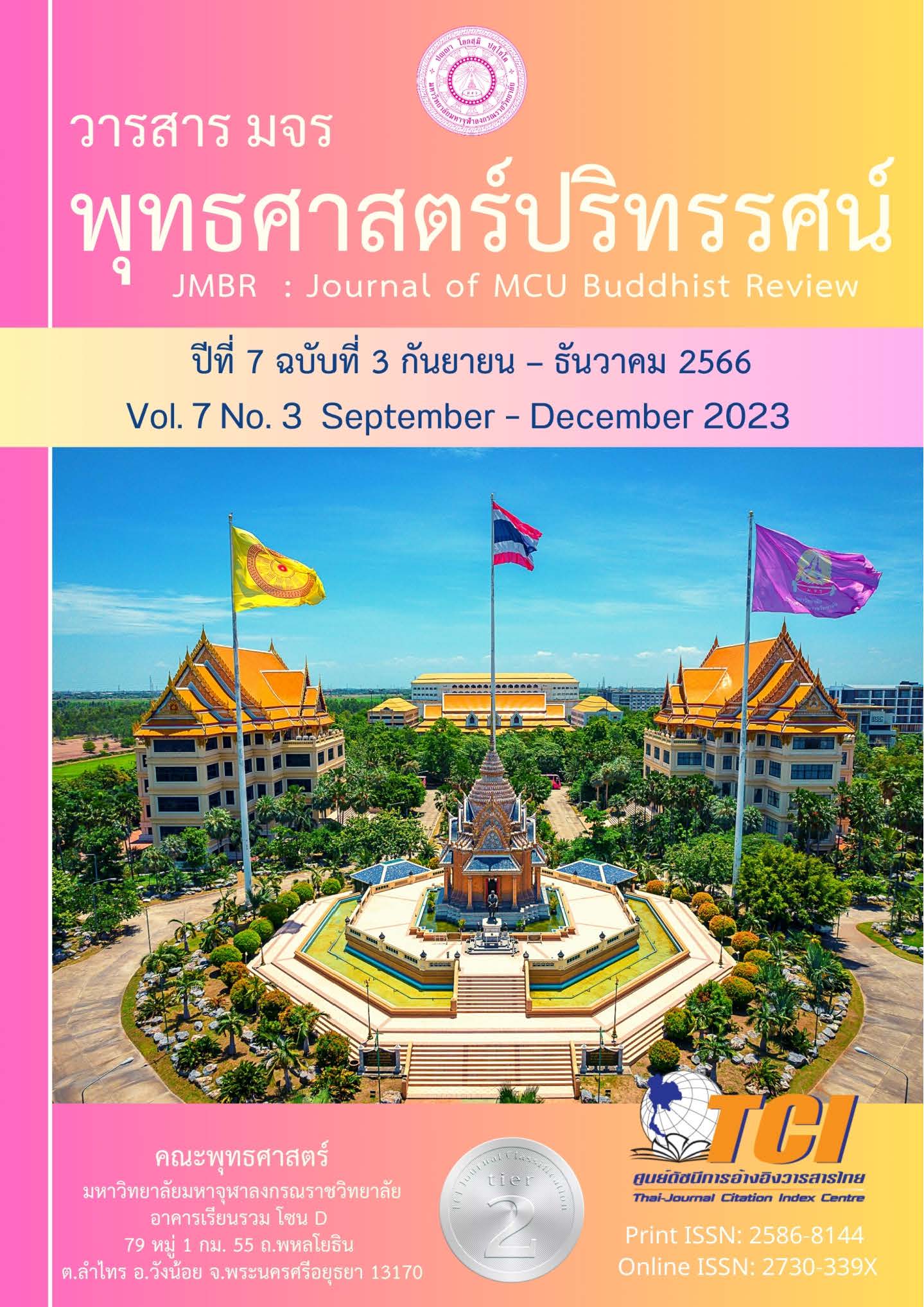ศึกษาเปรียบเทียบพิธีกรรมในโบสถ์ของพุทธศาสนาเถรวาทและพิธีกรรมในโบสถ์ของศาสนาคริสต์นิกายโรมันคาทอลิก
Main Article Content
บทคัดย่อ
บทความวิจัยนี้มีวัตถุประสงค์ 1) เพื่อศึกษาพิธีกรรมในโบสถ์ของศาสนาพุทธเถรวาท 2) เพื่อศึกษาพิธีกรรมในโบสถ์ของศาสนาคริสต์นิกายโรมันคาทอลิก 3) เพื่อเปรียบเทียบพิธีกรรมในโบสถ์ของศาสนาพุทธเถรวาทกับพิธีกรรมในโบสถ์ศาสนาคริสต์นิกายโรมันคาทอลิก เป็นการวิจัยเชิงเอกสาร ศึกษาวิเคราะห์ และนำเสนอผลการวิจัยด้วยพรรณนาวิธี
ผลการศึกษาพบว่า 1) พิธีกรรมในโบสถ์ของศาสนาพุทธเถรวาทหรืออุโบสถกรรม ที่จัดเป็นสังฆกรรมโดยเฉพาะที่จะต้องประชุมร่วมกันทำในโบสถ์เท่านั้น พบว่ามีพิธีกรรม ได้แก่ พิธีอุปสมบท คือ การบวชพระ พิธีสวดพระปาฎิโมกข์ คือ สวดสาธยายพระวินัยของสงฆ์ วุฎฐานพิธี คือ การอยู่ปริวาสกรรมเพื่อชำระศีล และพิธีกรานกฐิน คือ การรักษาผ้าครองกฐิน ซึ่งเป็นไปตามพระวินัยบัญญัติของพระพุทธเจ้าอันจะเป็นเหตุนำมา ซึ่งความสามัคคีของหมู่สงฆ์ 2) พิธีกรรมของศาสนาคริสต์นิกายโรมันคาทอลิกที่จะต้องทำในโบสถ์ ได้แก่ พิธีศีลศักดิ์สิทธิ์ 7 ข้อ ประกอบด้วย 1) ศีลล้างบาป 2) ศีลกำลัง 3) ศีลอภัยบาป 4) ศีลมหาสนิท 5) ศีลเจิมคนไข้ หรือเจิมครั้งสุดท้าย 6) ศีลสมรส 7) ศีลบวชหรืออนุกรม ซึ่งเป็นไปเพื่อความบริสุทธิ์ ความสุขทั้งในโลกนี้และโลกหน้า 3) เปรียบเทียบพิธีกรรมในโบสถ์ของศาสนาพุทธเถรวาทกับพิธีกรรมในโบสถ์ศาสนาคริสต์นิกายโรมันคาทอลิก พบว่า การบวชพระกับศีลบวชหรืออนุกรม และ การสวดปาฏิโมกข์กับพิธีศีลล้างบาปหรือศีลจุ่ม วุฎฐานพิธีกับศีลล้างบาป ทั้งหมดมีความสอดคล้องกันในด้านคุณค่า คือ ช่วยให้เกิดการเว้นชั่วกลัวบาป หมั่นเพียรสร้างกุศลความดี และประโยชน์ทางด้านจิตใจ คือ ช่วยให้เกิดความสบายใจ มีความมั่นใจในความดีที่ตนทำ ส่วนด้านจิตใจ ทำให้เกิดความสบายใจ มีเมตตา มีจิตอาสาช่วยเหลือผู้อื่น เป็นต้น ทั้งนี้พิธีกรรมที่เป็นทางการส่วนใหญ่แล้วจะประกอบพิธีในโบสถ์ ส่วนนัยยะที่ต่างกันจะเป็นด้านองค์ประกอบและเงื่อนไขช่วงเวลา ลำดับขั้นตอน และผู้ประกอบพิธีกรรมเท่านั้น
Article Details

อนุญาตภายใต้เงื่อนไข Creative Commons Attribution-NonCommercial-NoDerivatives 4.0 International License.
- บทความที่ได้รับการตีพิมพ์เป็นลิขสิทธิ์ของวารสาร มจร พุทธศาสตร์ปริทรรศน์
- ข้อความใดๆ ที่ปรากฎในบทความที่ได้รับการตีพิมพ์ในวารสาร ถือเป็นความรับผิดชอบของผู้เขียนบทความ และข้อคิดเห็นนั้นไม่ถือว่าเป็นทัศนะและความรับผิดชอบของกองบรรณาธิการวารสาร มจร พุทธศาสตร์ปริทรรศน์
เอกสารอ้างอิง
กรมการศาสนา กระทรวงวัฒนธรรม. (2551). การศาสนา. กรุงเทพฯ: ชุมนุมสหกรณ์การเกษตรแห่งประเทศไทย จำกัด.
กรมการศาสนา. (2547). คู่มือปฏิบัติงานศาสนิกสัมพันธ์. กรุงเทพฯ: กระทรวงวัฒนธรรม.
กรมการศาสนา กระทรวงวัฒนธรรม. (2552). พิธีกรรมและประเพณี. กรุงเทพฯ: ชุมนุมสหกรณ์การเกษตร แห่งประเทศไทย จำกัด.
พระครูบวรสิกขการ. (2547). พุทธจริยาวัตรและพระจริยาวัตรของพระเยซูคริสต์: การศึกษาเปรียบเทียบในมหาปรินิพพานสูตร กับพระวรสารลูกา. วิทยานิพนธ์พุทธศาสตรมหาบัณฑิต บัณฑิตวิทยาลัย: มหาวิทยาลัยมหาจุฬาลงกรณราชวิทยาลัย.
พระสามร พฺรหฺมเถโร. (2561). ศึกษาอุโบสถกรรมในคัมภีร์พุทธศาสนาเถรวาท. วิทยานิพนธ์พุทธศาสตรมหาบัณฑิต บัณฑิตวิทยาลัย: มหาวิทยาลัยมหาจุฬาลงกรณราชวิทยาลัย.
มหาจุฬาลงกรณราชวิทยาลัย. (2539). พระไตรปิฎกภาษาไทย ฉบับมหาจุฬาลงกรณราชวิทยาลัย. กรุงเทพฯ: โรงพิมพ์มหาจุฬาลงกรณราชวิทยาลัย.
ราชบัณฑิตยสถาน. (2524). พจนานุกรมศัพท์สังคมวิทยา อังกฤษ-ไทย ฉบับราชบัณฑิตยสถาน. กรุงเทพฯ: ราชบัณฑิตยสถาน.
ศิริพจน์ สกุลทอง. (2546). กระบวนการสืบทอดจากสื่อสัญลักษณ์ทางพิธีกรรมศีลศักดิ์สิทธิ์ 7 ประการ ไปสู่ความเชื่อศรัทธาและการดำเนินชีวิตทางธุรกิจแบบมีจริยธรรมของชุมชนชาวคริสต์ (โรมันคาทอลิก) ของโบสถ์พระมารดานิจจานุเคราะห์ กรุงเทพมหานคร. วิทยานิพนธ์นิเทศศาสตรมหาบัณฑิต บัณฑิตวิทยาลัย: มหาวิทยาลัยธุรกิจบัณฑิต.
สมเด็จพระมหาสมณเจ้า กรมพระยาวชิรญาณวโรรส. (2538). วินัยมุข เล่ม 3. พิมพ์ครั้งที่ 20. กรุงเทพฯ: สำนักพิมพ์มูลนิธิมหามกุฏราชวิทยาลัย.
สมคิด จิรทัศนกุล. (2547). รูปแบบพระอุโบสถและพระวิหารในสมัยพระบาทสมเด็จพระจอมเกล้าเจ้าอยู่หัว. กรุงเทพฯ: บริษัทวิริยะธุรกิจ จำกัด.
สมิทธ์ สระอุบล. (2534). มานุษยวิทยาเบื้องต้น. กรุงเทพฯ: สำนักพิมพ์โอเดียนสโตร์.
เสฐียร พันธรังสี. (2563). ศาสนาเปรียบเทียบ. พิมพ์ครั้งที่ 8. กรุงเทพฯ: บ.เยลโล่ การพิมพ์ จำกัด.


